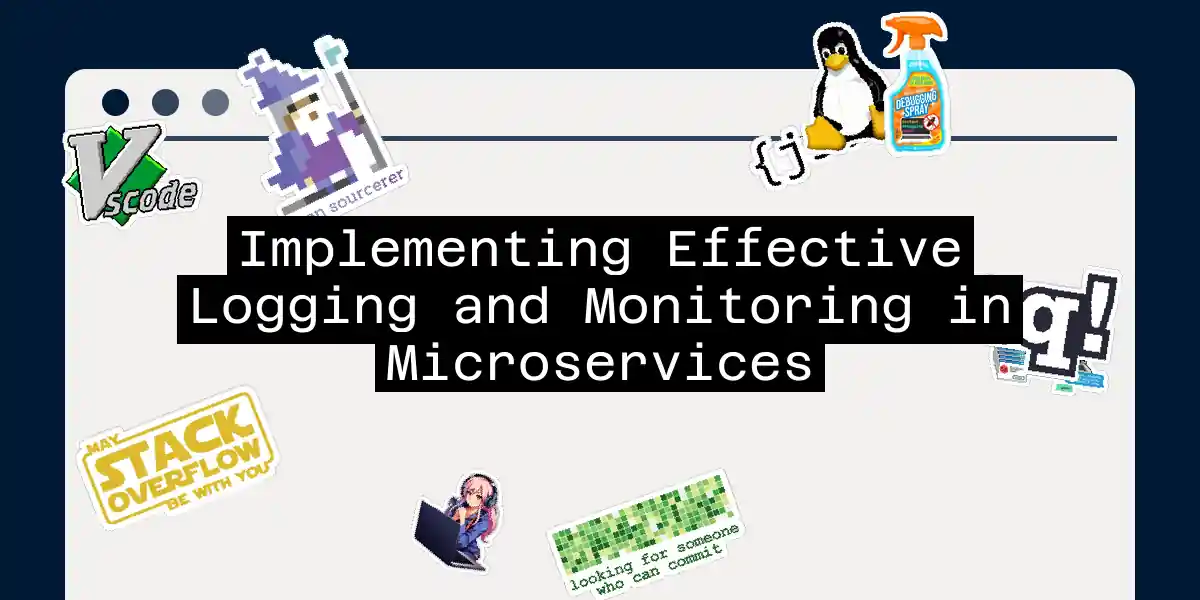Understanding Microservices Logging
Microservices architecture has become a cornerstone of modern software development, offering scalability, flexibility, and resilience. However, this distributed approach introduces unique challenges in system monitoring and troubleshooting. Effective logging is crucial for maintaining visibility and diagnosing issues in these complex environments.
Why Logging is Critical in Microservices
Logging in microservices is essential for several reasons:
- Distributed Debugging: Logs help trace requests across multiple services, which is vital for identifying the root cause of issues.
- Performance Monitoring: Log data provides insights into service performance, helping to identify bottlenecks and optimize resource utilization.
- Security Auditing: Logs are crucial for detecting and investigating security incidents across the distributed system.
- Compliance: Comprehensive logging is often required for regulatory compliance in various industries.
Best Practices for Microservices Logging
Implementing effective logging in microservices involves several key practices:
1. Standardize Log Formats
Standardizing log formats across all services is crucial for consistency and ease of analysis. This can be achieved by using structured logging formats such as JSON, which allows for easy parsing and correlation of logs.
2. Centralize Logs
Centralizing logs in a log management system simplifies log collection, analysis, and correlation. Tools like ELK Stack (Elasticsearch, Logstash, Kibana) or cloud-native solutions can be used to centralize logs.
3. Correlate Logs
Using correlation IDs consistently across all services helps in tracing requests across the distributed system. This is particularly useful for troubleshooting complex service interactions.
4. Implement Distributed Tracing
Distributed tracing tools like OpenTelemetry, Jaeger, or Zipkin help in tracking requests across multiple services, providing end-to-end visibility into system interactions.
5. Handle Log Volume and Performance Metrics
Managing the high volume of logs generated by microservices involves implementing log rotation, compression, and sampling. Additionally, logging performance metrics such as response times, throughput, and error rates helps in monitoring the health and efficiency of the system.
Managing Logging Challenges
Managing Log Volume
- Log Rotation and Compression: Regularly rotate logs to prevent them from growing indefinitely and compress them to save storage space.
- Log Sampling: Sample logs from high-volume services to reduce the overall log volume without losing critical information.
- Retention Policies: Set appropriate retention policies to ensure logs are kept for a sufficient amount of time for analysis and compliance.
Ensuring Consistency Across Polyglot Services
- Define Logging Standards: Define and enforce logging standards across teams to ensure consistency in log formats and content.
- Use Language-Agnostic Formats: Use formats like JSON that are language-agnostic to ensure logs can be easily parsed and analyzed regardless of the programming language used.
- Centralized Logging Configuration: Implement centralized logging configuration management to ensure uniform logging practices across all services.
Handling Containerized and Serverless Environments
- Container-Aware Logging Drivers: Use container-aware logging drivers such as Docker’s json-file driver to handle logs in containerized environments.
- Structured Logging: Implement structured logging to make it easier to parse and analyze logs in serverless functions.
- Cloud-Native Logging Solutions: Leverage cloud-native logging solutions designed for serverless functions to manage logs effectively.
Security Considerations
Securing Log Data
- Data Encryption: Encrypt log data both in transit and at rest to protect sensitive information.
- Avoid Logging Sensitive Data: Avoid logging sensitive information such as social security numbers, credit card details, and email addresses.
- Regular Backups and Disaster Recovery: Regularly back up log data and ensure these backups are encrypted to prevent unauthorized access.
- Monitoring and Intrusion Detection: Implement real-time monitoring and intrusion detection systems to identify security threats.
- Authentication and Authorization: Implement strong authentication and authorization mechanisms to restrict access to sensitive log data.
Tools and Technologies for Effective Logging
Log Management Tools
Tools like ELK Stack, Splunk, and Papertrail can be used to centralize, analyze, and correlate logs. These tools provide features such as log aggregation, search, and visualization, making it easier to manage and analyze log data.
Distributed Tracing Tools
Tools like OpenTelemetry, Jaeger, and Zipkin are designed for distributed tracing and provide end-to-end visibility into system interactions. These tools help in identifying performance bottlenecks and troubleshooting complex issues.
Implementing Effective Monitoring
Centralized Monitoring
Implementing centralized monitoring involves collecting metrics and logs from all services and aggregating them in a single system. This can be achieved using tools like Prometheus, Grafana, and New Relic.
Using Metrics and Distributed Tracing
Using metrics and distributed tracing helps in monitoring the performance and behavior of microservices. Metrics such as response times, throughput, and error rates provide insights into system performance, while distributed tracing helps in identifying bottlenecks and issues.
Conclusion
Implementing effective logging and monitoring in microservices is crucial for maintaining system visibility, diagnosing issues, and ensuring performance and security. By standardizing log formats, centralizing logs, correlating logs, and implementing distributed tracing, you can significantly enhance your system’s observability and manageability. Additionally, ensuring log security and using appropriate tools and technologies can help in managing the complexities of microservices architectures. By following these best practices, you can build robust and highly observable microservices-based applications.
